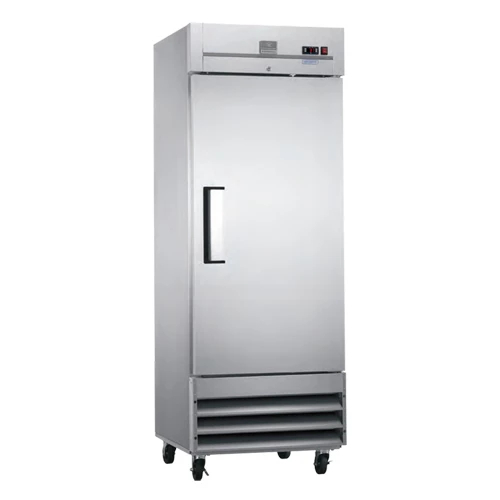
For those buying commercial refrigeration for the first time, browsing the selection of units available can be a maze of confusing and unrecognizable terms. Among the most primary of options are the “top-mount refrigerator” and the “bottom-mount refrigerator.” That’s a choice that may leave many new to the world of restaurant equipment wondering what the difference is and which one might be better for their location.
To answer those questions, we’ve compiled some information about each type of commercial cooler, including the situations that each is preferable for, as well as the advantages and disadvantages of each.
Bottom-mount Refrigerator Guide

Best commercial refrigerator for:
Hot areas and cooking line applications.
Pros:
- The condenser operates near the floor, where temperatures are cooler – perhaps as much as 15 degrees cooler than at the top of the commercial refrigerator.
- With no ladders or supports required, servicing and cleaning the compressor is easier. Plus, service calls only take one person, which can substantially lessen the cost.
- Main operating components of your commercial refrigerator or commercial freezer are away from rising grease-laden steam that can gum up the compressor, making it less efficient and requiring more maintenance.
- With the condenser elevating the bottom of the commercial cooler’s interior, the user doesn’t have to stoop to access items stored there.
Cons:
- Operates near the floor, which means the condenser can pull in dust and debris from that area, trapping it in the coils. It may also draw in spilled ingredients like a dropped bag of flour.
- Heat from the system can rise into the cabinet, a potential that could make this type of commercial refrigeration less efficient.
- Transporting the cooled refrigerant from the condenser to the evaporator and then back again requires that lines be run through the back of the cabinet, which takes up a small amount of cold storage space.
- Costs more to build because of added insulation to keep heat from the refrigeration system from rising into the cabinet, having longer lines for refrigerant, and having a larger motor to move that refrigerant through those lines.
Top-mount Refrigerator Guide

Best commercial refrigeration for:
Dry storage areas where ingredients might be spilled and locations where the floor can become dusty.
Pros:
- There’s no worry of the condenser fan pulling in dust or debris from the floor and clogging the coils.
- Heat from the system doesn’t rise right into the commercial cooler, which can mean more efficient operation.
- Since the condenser, compressor, and evaporator are all together at the top of this type of commercial cooler, there’s no need for refrigerant lines to be built into the back of the box. That not only means they’re more accessible for service, it also means you get some extra cold storage space.
- Having the compressor on top of the cabinet maximizes the space inside. With a bottom-mount refrigerator, insulation must be installed above the refrigeration system, which takes up space. Users also have to rely on the top shelves, which are harder to reach and difficult to see. A top-mount refrigerator has lower top shelves, which means they’re easier to put to use.
Cons:
- This type of commercial refrigerator and commercial freezer is not well-suited for cooking line applications because they can draw in grease-laden steam, which can clog condenser coils.
- Since heat rises, their location at the top of the commercial cooler puts them in the warmest part of the kitchen, making them less efficient.
- Since the compressor is situated at or above the heads of most people, it’s harder to access that area in this type of commercial refrigeration unit for cleaning. Additionally, service that requires any part of the system to be removed may well take two technicians and special equipment, which can run your bills up substantially.
